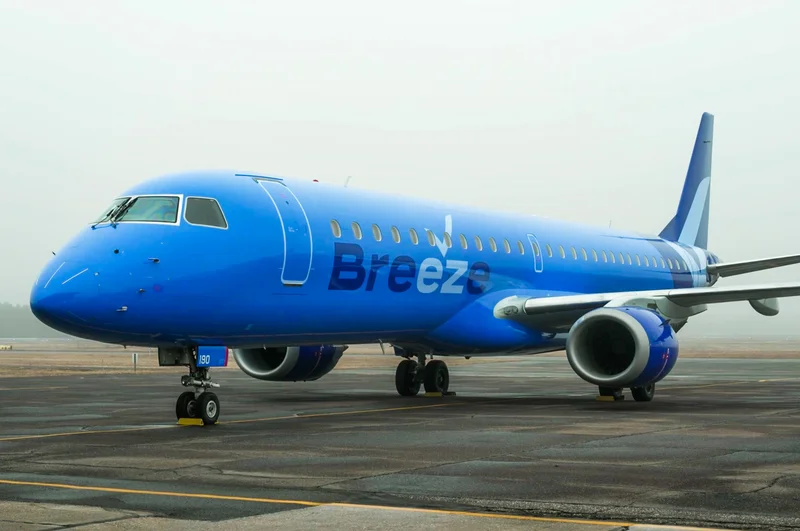Generated Title: Breeze Airways' New Vegas Routes: A Calculated Gamble or Just Hot Air?
Breeze Airways is expanding its footprint in Las Vegas, launching four new routes in early 2026. Daily nonstop flights to Orange County (SNA) start March 6th, alongside twice-weekly flights to Twin Falls, Idaho (TWF), and Arcata/Eureka, California (ACV). Lincoln, Nebraska (LNK), gets twice-weekly service beginning April 8th. The question is: are these routes a smart strategic move, or simply a way to fill planes?
Route Expansion: The Devil's in the Data
Let's break down the numbers. Breeze is touting promotional one-way fares as low as $39. While eye-catching, these fares are available only until November 10th, 2025, and for travel between March 6th and May 12th. This suggests a strategy focused on generating initial buzz and bookings, but what happens after the promotional period ends? Will demand sustain these routes at higher prices? Breeze Adds New Routes With Fares Starting at $39 One-Way.
The choice of destinations is also interesting. Orange County is a relatively high-traffic market, so the daily nonstop flights make sense. Twin Falls, Arcata/Eureka, and Lincoln, however, are smaller markets. While Breeze CEO David Neeleman highlights the "growing community in Twin Falls," the twice-weekly flights suggest a more cautious approach. Are they testing the waters before committing to more frequent service?
It's also worth noting the "BreezeThru" service to Orange County via Twin Falls. This one-stop, no-change-of-planes option could be attractive to travelers from smaller markets who want to avoid connections in larger, more congested airports. But how much of a premium are passengers willing to pay for this convenience? And what happens if the Las Vegas flight is delayed, causing passengers to miss their connection to Orange County? (The knock-on effect on customer satisfaction could be significant).
Digging Deeper: The Low-Cost Carrier Equation
Breeze Airways operates on a low-cost carrier (LCC) model, which means squeezing costs wherever possible. They fly Airbus A220-300 jets, which are relatively fuel-efficient, and they focus on secondary markets to avoid competition with larger airlines. But even with these cost-saving measures, profitability is not guaranteed.
One key factor is load factor – the percentage of seats that are filled on each flight. If Breeze can consistently achieve high load factors on these new routes, they have a good chance of success. But if load factors are low, they may struggle to cover their operating costs.

Another factor is ancillary revenue – the fees that airlines charge for things like baggage, seat selection, and food. LCCs rely heavily on ancillary revenue to boost their bottom lines. Breeze offers free Wi-Fi and family seating, which could be seen as a competitive advantage, but they also charge for other extras. How effectively they can monetize these extras will be crucial to their profitability.
I've looked at hundreds of airline route announcements. Most of them read like press releases. What I find interesting here is the lack of any mention of projected load factors or revenue targets. Are Breeze's internal projections optimistic? Or are they simply keeping their cards close to their chest?
Is This a Sustainable Model?
Breeze Airways is banking on attracting leisure travelers with low fares and convenient routes. The airline is adding Twin Falls, Idaho, to its route map. As of March 6, 2026, the airline will offer nonstop service to Las Vegas (LAS) on Mondays and Fridays, and 1-stop “BreezeThru” service to Orange County (SNA), also on Mondays and Fridays. Introductory fares between Twin Falls and Las Vegas start at $49 each way. The question is whether this strategy is sustainable in the long run. The airline industry is notoriously volatile, and LCCs are particularly vulnerable to fluctuations in fuel prices and economic conditions.
Moreover, Breeze faces competition from other LCCs and from larger airlines that are increasingly offering unbundled fares. To succeed, Breeze needs to differentiate itself through superior customer service, innovative products, or a unique network of routes.
The promotional fares are valid for bookings made through November 10, 2025. The promotional fares must be purchased by Nov. 10 and are valid for travel from March 6 through May 12. What happens after those dates? The numbers don't lie. If Breeze can't maintain high load factors and generate sufficient ancillary revenue, these new routes could become a drag on their overall performance.
Just a Flight of Fancy?
Breeze's expansion into Las Vegas is a calculated gamble. The new routes offer potential upside, but they also carry significant risks. Only time will tell whether these routes will prove to be a smart strategic move or just hot air.









